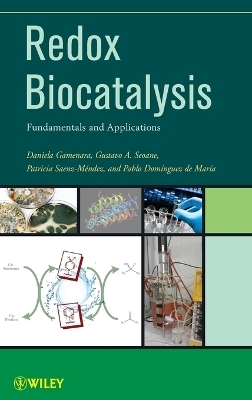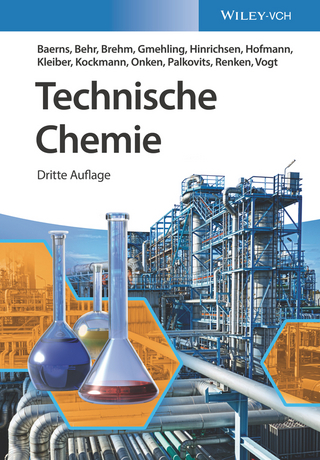
Redox Biocatalysis
John Wiley & Sons Inc (Verlag)
978-0-470-87420-2 (ISBN)
Paves the way for new industrial applications using redox biocatalysis
Increasingly, researchers rely on the use of enzymes to perform redox processes as they search for novel industrial synthetic routes. In order to support and advance their investigations, this book provides a comprehensive and current overview of the use of redox enzymes and enzyme-mediated oxidative processes, with an emphasis on the role of redox enzymes in chemical transformations. The authors examine the full range of topics in the field, from basic principles to new and emerging research and applications. Moreover, they explore everything from laboratory-scale procedures to industrial manufacturing.
Redox Biocatalysis begins with a discussion of the biochemical features of redox enzymes as well as cofactors and cofactor regeneration methods. Next, the authors present a variety of topics and materials to the research and development of full-scale industrial applications, including:
Biocatalytic applications of redox enzymes such as dehydrogenases, oxygenases, oxidases, and peroxidases
Enzyme-mediated oxidative processes based on biocatalytic promiscuity
All the steps from enzyme discovery to robust industrial processes, including directed evolution, high-throughput screening, and medium engineering
Case studies tracing the development of industrial applications using biocatalytic redox reactions
Each chapter ends with concluding remarks, underscoring the key scientific principles and processes. Extensive references serve as a gateway to the growing body of research in the field.
Researchers in both academia and industry will find this book an indispensable reference for redox biotransformations, guiding them from underlying core principles to new discoveries and emerging industrial applications.
Daniela Gamenara, PhD, is Assistant Professor in the Organic Chemistry Department of the Faculty of Chemistry of Universidad de la República, Uruguay. After two short postdoctoral internships, her current scientific interest is the development of enzymatic methodologies for the synthesis of high added-value compounds and natural products as well, together with the use of new trends in organocatalysis for the same purposes. Gustavo A. Seoane, PhD, is Full Professor and Head of the Organic Chemistry Department of the Faculty of Chemistry of Universidad de la República, Uruguay. His main scientific interest is the use of green procedures for the synthesis of bioactive natural products and analogs, in particular, intensive use of biotransformations to prepare polyoxygenated targets. He works actively to promote the development of biocatalysis in South America. Patricia Saenz-Méndez, PhD, is Assistant Professor of Physical Organic Chemistry in the Faculty of Chemistry of Universidad de la República, Uruguay. She was previously appointed as postdoctoral fellow at the Örebro University, Sweden, and the National University of Ireland, Galway. Her work is devoted to the experimental and in silico development of biotechnological and organocatalytic tools for the preparation of high added-value chemicals and natural products. Pablo Domínguez de María, PhD, is Group Leader at the Institute for Technical and Macromolecular Chemistry (ITMC), RWTH Aachen University, Germany. He was previously affiliated with AkzoNobel BV in the Netherlands and Degussa AG in Germany. Dr. Domínguez de María has also worked as a technical freelance advisor on emerging technologies (e.g., catalysis) applied to sustainable chemistry (www.sustainablemomentum.net). He was awarded the Young Scientist Prize by the Iberoamerican Academy of Pharmacy.
PREFACE ix
1. Enzymes Involved in Redox Reactions: Natural Sources and Mechanistic Overview 1
1.1 Motivation: Green Chemistry and Biocatalysis 1
1.2 Sources of Biocatalysts 2
1.2.1 Plants and Animals as Sources of Redox Biocatalysts 3
1.2.2 Wild-Type Microorganisms 7
1.2.2.1 Yeasts 7
1.2.2.2 Fungi 8
1.2.2.3 Bacteria 8
1.2.3 Metagenomic Assessments 9
1.3 Overview of Redox Enzymes 10
1.3.1 Dehydrogenases 13
1.3.1.1 Zn-Dependent Dehydrogenases 14
1.3.1.2 Flavin-Dependent Dehydrogenases 15
1.3.1.3 Pterin-Dependent Dehydrogenases 16
1.3.1.4 Quinoprotein Dehydrogenases 17
1.3.1.5 Dehydrogenases without Prosthetic Group 18
1.3.2 Oxygenases 19
1.3.2.1 Monooxygenases 20
1.3.2.2 Dioxygenases 38
1.3.3 Oxidases 50
1.3.3.1 Iron-Containing Oxidases 50
1.3.3.2 Copper-Containing Oxidases 51
1.3.3.3 Flavin-Dependent Oxidases 56
1.3.4 Peroxidases 61
1.4 Concluding Remarks 64
References 64
2. Natural Cofactors and Their Regeneration Strategies 86
2.1 Types of Natural Cofactors—Mechanisms 86
2.2 Cofactor Regeneration 88
2.2.1 Enzymatic Regeneration of Reduced Cofactors 88
2.2.1.1 Substrate-Assisted Method 88
2.2.1.2 Enzyme-Assisted Method 89
2.2.2 Enzymatic Regeneration of Oxidized Cofactors 92
2.2.3 Chemical Regeneration of Cofactors 94
2.2.4 Electrochemical Regeneration of Cofactors 95
2.2.5 Photochemical Regeneration of Cofactors 96
2.3 Concluding Remarks 97
References 98
3. Reactions Involving Dehydrogenases 101
3.1 General Considerations 101
3.2 Reduction of Carbonyl Groups 105
3.2.1 Reduction of Aliphatic and Aromatic Ketones 106
3.2.2 Reduction of α- and β-keto Esters and Derivatives 119
3.2.3 Reduction of Diketones 126
3.2.4 Reduction of Aldehydes 128
3.3 Racemization and Deracemization Reactions 130
3.4 Preparation of Amines 135
3.5 Reduction of C–C Double Bonds 142
3.6 Oxidation Reactions 152
3.7 Dehydrogenase-Catalyzed Redox Reactions in Natural Products 159
3.8 Concluding Remarks 164
References 165
4. Reactions Involving Oxygenases 180
4.1 Monooxygenase-Catalyzed Reactions 180
4.1.1 Hydroxylation of Aliphatic Compounds 181
4.1.2 Hydroxylation of Aromatic Compounds 187
4.1.3 Baeyer–Villiger Reactions 189
4.1.3.1 Classification and Metabolic Role of BVMOs 192
4.1.3.2 Isolated Enzymes versus Whole-Cell Systems (Wild-Type and Recombinant Microorganisms) 194
4.1.3.3 Substrate Profile of Available Baeyer–Villiger Monooxygenases 195
4.1.3.4 Synthetic Applications of BVMOs 201
4.1.4 Epoxidation of Alkenes 240
4.2 Dioxygenase-Catalyzed Reactions 251
4.2.1 Aromatic Dioxygenases 251
4.2.1.1 Dihydroxylation of Aromatic Compounds 251
4.2.1.2 Other Oxidation Reactions Performed by Aromatic Dioxygenases 274
4.2.2 Miscellaneous Dioxygenases 279
4.2.2.1 Lipoxygenase 279
4.3 Concluding Remarks 285
References 286
5. Reactions Involving Oxidases and Peroxidases 303
5.1 Oxidase-Catalyzed Reactions 304
5.1.1 Oxidases Acting on C–O Bonds 304
5.1.1.1 Galactose Oxidase 304
5.1.1.2 Pyranose Oxidase 308
5.1.1.3 Alcohol Oxidase 311
5.1.1.4 Glucose Oxidase 313
5.1.1.5 Glycolate Oxidase 313
5.1.2 Laccases and Tyrosinases (Phenol Oxidases) 315
5.1.2.1 Laccase 315
5.1.2.2 Tyrosinase and Other Polyphenol Oxidases 352
5.1.3 Oxidases Acting on C–N Bonds 361
5.1.3.1 d-Amino Acid Oxidase 361
5.1.3.2 l-Amino Acid Oxidase 368
5.1.3.3 Monoamine Oxidase 368
5.1.3.4 Copper Amine Oxidases 371
5.1.4 Miscellaneous 371
5.1.4.1 Cholesterol Oxidase 372
5.1.4.2 Vanillyl Alcohol Oxidase 373
5.1.4.3 Alditol Oxidase 373
5.2 Peroxidase-Catalyzed Reactions 375
5.2.1 Peroxidase Mediated Transformations 379
5.2.1.1 Oxidative Dehydrogenation (2 RH + H2O2 → 2 R• + 2 H2O→R-R) 379
5.2.1.2 Oxidative Halogenation (RH + H2O2 +X− + H+→RX + 2 H2O) 385
5.2.1.3 Oxygen-Transfer Reactions (RH + H2O2 → ROH + H2O) 390
5.3 Concluding Remarks 403
References 404
6. Hydrolase-Mediated Oxidations 433
6.1 Hydrolase Promiscuity and in situ Peracid Formation. Perhydrolases vs. Hydrolases. Other Promiscuous Hydrolase-Mediated Oxidations 433
6.2 Hydrolase-Mediated Bulk Oxidations in Aqueous Media (e.g., Bleaching, Disinfection, etc.) 436
6.3 Lipase-Mediated Oxidations: Prileshajev Epoxidations and Baeyer–Villiger Reactions 439
6.4 Hydrolase-Mediated Oxidation and Processing of Lignocellulosic Materials 445
6.5 Concluding Remarks 448
References 448
7. Bridging Gaps: From Enzyme Discovery to Bioprocesses 453
7.1 Context 453
7.2 Enzyme Directed Evolution and High-Throughput-Screening of Biocatalysts 454
7.3 Successful Case: Baker’s Yeast Redox Enzymes, Their Cloning, and Separate Overexpression 467
7.4 Whole-Cells vs. Isolated Enzymes: Medium Engineering 473
7.5 Beyond: Multistep Domino Biocatalytic Processes 477
7.6 Concluding Remarks 482
References 483
8. Industrial Applications of Biocatalytic Redox Reactions: From Academic Curiosities to Robust Processes 487
8.1 Motivation: Drivers for Industrial Biocatalytic Processes 487
8.2 Key Aspects in Industrial Biocatalytic Processes 488
8.3 Industrial Biocatalytic Redox Processes: Free Enzymes 492
8.4 Industrial Biocatalytic Redox Processes—Whole-Cells: The “Designer Bug” Concept and Beyond (Metabolic Engineering) 500
8.5 Concluding Remarks and Future Perspectives 511
References 516
INDEX 521
| Verlagsort | New York |
|---|---|
| Sprache | englisch |
| Maße | 165 x 241 mm |
| Gewicht | 903 g |
| Themenwelt | Naturwissenschaften ► Chemie ► Technische Chemie |
| Technik | |
| ISBN-10 | 0-470-87420-1 / 0470874201 |
| ISBN-13 | 978-0-470-87420-2 / 9780470874202 |
| Zustand | Neuware |
| Haben Sie eine Frage zum Produkt? |
aus dem Bereich


